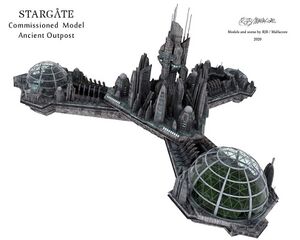| Prism Terminal | ||||||||||||||||

| ||||||||||||||||
| Prism Terminal | ||||||||||||||||
| ||||||||||||||||
Prism Terminal is a strategically positioned space station in the Noera Star System, established in 2386 to function as a sensor net and relay outpost on the edge of Serenity Concord space. Equipped with an advanced long-range sensor array, the station scans vast regions of space with exceptional precision, detecting celestial phenomena, space weather patterns, and potential threats. Its location near the Hermod Gate allows for swift transit of personnel and equipment to the edge of Concord territory. The station's multi-spectrum observatories provide detailed celestial studies, while specialized subsurface imaging probes aid archaeological expeditions on Souyama. Additionally, Prism Terminal houses a specialized Temporal Anomaly Detection System (TADS) for monitoring temporal disruptions in the Tau Majestius Sector.
Special Capabilities
The state-of-the-art Advanced Sensor Array allows Prism Terminal to scan vast regions of space with high resolution and precision, providing crucial data on celestial phenomena, space weather patterns, and potential threats. Second, a network of Multi-Spectrum Observatories strategically placed across the Noera Star System allows for detailed studies of planets' atmospheres, surfaces, and geological activities in various wavelengths. Third, specialized Subsurface Imaging Probes expedite archaeological expeditions on Souyama, revealing hidden structures and artifacts beneath the frozen surface. Lastly, the station's highly advanced Temporal Anomaly Detection System (TADS) plays a pivotal role in monitoring for time disruptions and anomalies in the temporal-rich Tau Majestius Sector, safeguarding against potential dangers and contributing to a deeper understanding of temporal phenomena.
- Advanced Sensor Array
- Prism Terminal is equipped with an advanced long range sensor array capable of scanning a vast region of space with exceptional precision and sensitivity. This cutting-edge technology enables the station to detect and analyze subtle changes in celestial phenomena, space weather patterns, and potential threats from a considerable distance, providing early warnings and crucial data for strategic decision-making.
- Multi-Spectrum Observatories
- The station houses a network of multi-spectrum observatories strategically positioned across the Noera Star System. These observatories can observe the celestial bodies in various wavelengths, from infrared to ultraviolet, allowing researchers to study the planets' atmospheres, surface compositions, and geological activities with unparalleled detail. This versatility enhances the depth and accuracy of scientific studies conducted at Prism Terminal.
- Subsurface Imaging Probes
- To support the archaeological expeditions on Souyama, the station employs specialized subsurface imaging probes. These probes use advanced ground-penetrating radar and tomography techniques to scan beneath the icy surface, revealing ancient structures, artifacts, and possible traces of the lost civilization. The use of subsurface imaging probes greatly accelerates the pace and precision of archaeological discoveries on the frozen world.
- Temporal Anomaly Detection System
- Prism Terminal boasts a highly specialized Temporal Anomaly Detection System (TADS) that monitors the surrounding space for potential disruptions in the fabric of time. This system is essential in the Tau Majestius Sector, known for occasional temporal disturbances and anomalies. TADS not only aids in understanding the nature of temporal phenomena but also assists in avoiding potential dangers posed by temporal instabilities.
Research Projects
The research projects at Prism Terminal with a primary focus on archaeology are centered around exploring and uncovering evidence of an ancient civilization on Souyama, the eighth planet of the Noera Star System. Led by a team of archaeologists, historians, and experts in ancient cultures, extensive expeditions are conducted on Souyama's frozen surface using advanced excavation techniques and remote sensing technologies. The team aims to discover and analyze remnants of this lost civilization, piecing together its history, technological advancements, and cultural practices. The archaeological studies not only offer insights into the enigmatic past of Souyama but also have broader implications for understanding the potential for life and civilizations beyond Earth, making them a key scientific endeavor at Prism Terminal.
- Archaeological Expeditions
- Prism Terminal's primary scientific project centers on extensive archaeological expeditions on Souyama, the eighth planet of the Noera Star System. Researchers employ advanced excavation techniques and remote sensing technologies to explore the planet's frozen surface and uncover evidence of a potential ancient civilization. Understanding this lost society's history and culture provides valuable insights into the conditions for life beyond Earth.
- Space Weather and Solar Flares
- The station maintains an active program to study space weather phenomena, particularly solar flares, and their impact on the star system's planets and space infrastructure. Advanced telescopes and monitoring equipment are used to observe solar activity, enabling improved early warning systems and safety measures for space missions and communication networks.
- Stellar Dynamics and Classification
- Researchers at Prism Terminal focus on studying the dynamics and characteristics of the central star, an A6 IV White Subgiant in the Noera Star System. Using spectroscopy and observational techniques, they analyze the star's properties to enhance understanding of stellar evolution and classification, aiding navigation and astronomical observations in the region.
History
Prism Terminal was established in the year 2386. The primary goal behind its creation was to serve as a strategic sensor net and relay outpost situated on the outskirts of Serenity Concord space. Its strategic position close to the edge of the Concord territory allowed for increased situational awareness and surveillance of potential threats and activities in the region. Beyond its core function as a sensor station, the Noera Star System presented a wealth of scientific opportunities that piqued the interest of researchers and explorers alike. The system's diverse array of planets with their unique characteristics and challenges offered a valuable platform for various scientific investigations, making Prism Terminal an attractive destination for Solas Tempus and other scientific organizations.